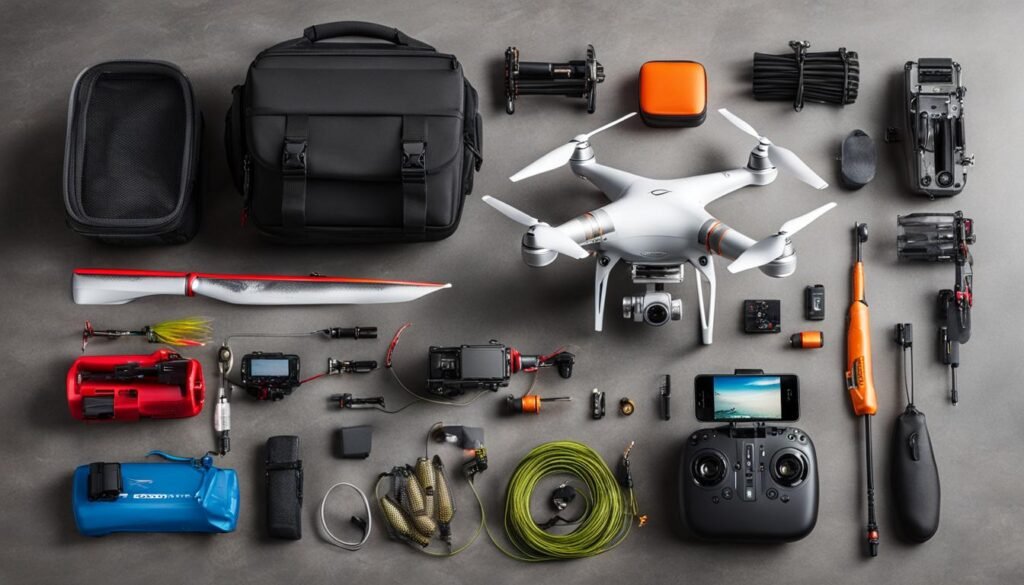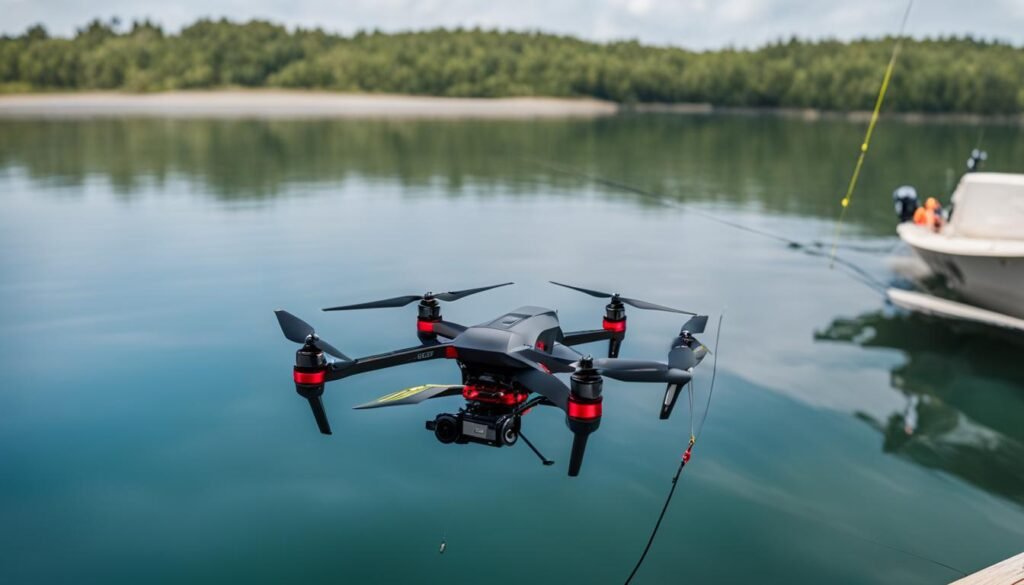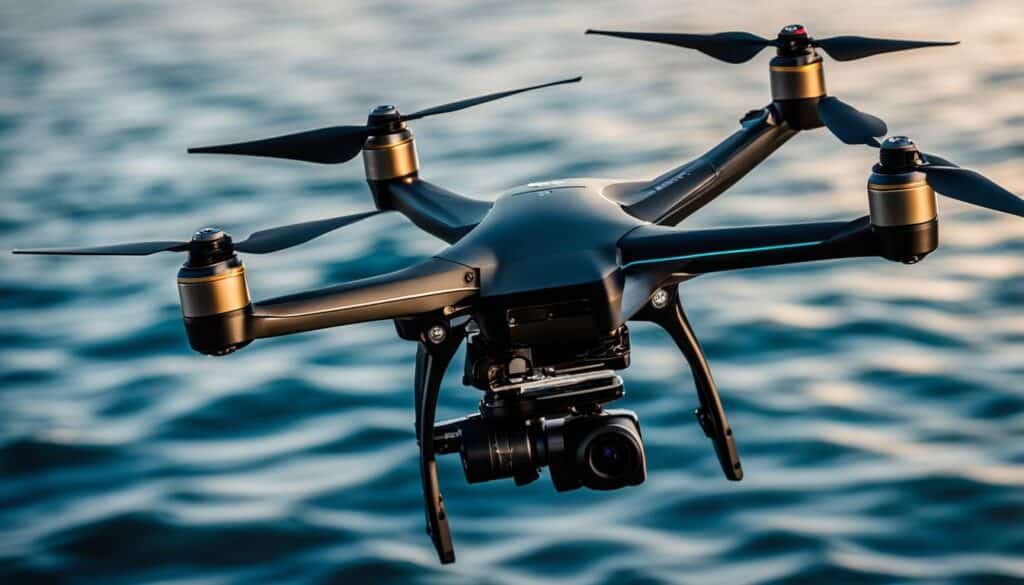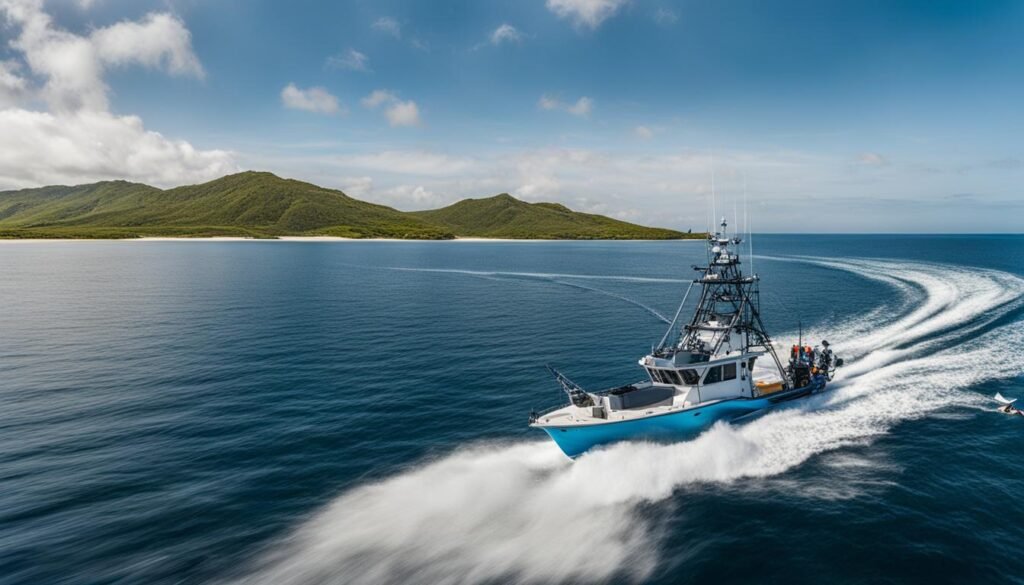Drone fishing is revolutionizing the way anglers approach their favorite pastime. With the right gear, anglers can now cast their bait further, reach inaccessible fishing spots, and increase their chances of catching bigger fish. Whether you’re a seasoned angler or just starting out, investing in the essential drone fishing gear is a game-changer.

Choosing the Right Drone for Fishing
When it comes to drone fishing, it’s crucial to select the perfect drone for your angling adventures. While there is a wide variety of options available, not all drones are suitable for fishing. The good news is that there are two exceptional choices that stand out among the rest: the Splashdrone and the DJI Phantom.
The Splashdrone is specifically designed for fishing and is considered one of the best drones for this purpose. Its waterproof construction ensures durability and peace of mind, even in wet environments. What sets the Splashdrone apart is its built-in release mechanism, allowing you to drop bait precisely where you want it, enhancing your chances of a successful catch.
Another exceptional option for fishing is the DJI Phantom. Known for its lifting capacity and impressive control range, the DJI Phantom is a favorite among anglers. Its stability and maneuverability make it ideal for drone fishing, enabling you to explore different fishing spots and reach those hard-to-reach areas with ease.
While the Splashdrone and DJI Phantom are highly recommended, it’s worth noting that other drones can also be used for fishing. However, these two models offer features and capabilities specifically tailored for anglers, making them the best choices for a successful drone fishing experience.
Essential Accessories for Drone Fishing
In addition to the drone itself, there are a few essential accessories that every drone fishing enthusiast should have. These accessories will not only enhance your fishing experience but also ensure that you are well-prepared out on the water.
Spare Batteries
When it comes to drone fishing, longer flight times mean more time spent searching for fish and dropping your bait in the perfect spot. Therefore, it is crucial to invest in spare batteries for your drone. Having extra batteries on hand will give you the freedom to extend your fishing sessions without interruptions. So, make sure to pack a few extra batteries before heading out on your fishing adventures.
Suitable Rod and Reel
A suitable rod and reel setup is essential for drone fishing. Opt for a large capacity surfcasting reel spooled with braided line. The braided line has a smaller diameter, allowing you to spool more line onto your reel. This is crucial since drone fishing enables you to cast your bait further than ever before. Pair your reel with a rod that has the right amount of flexibility and strength to handle the increased casting distance. This combination will ensure that you have both the power and control to reel in your catch.
Rod Holder or Beach Spike
Controlling your drone while simultaneously managing your bait in the water can be challenging. That’s where a rod holder or beach spike comes in handy. These accessories provide a secure and stable place to rest your rod, allowing you to have a free hand to control your drone. This way, you can focus on maneuvering the drone and drop your bait with precision without worrying about holding your rod.
Make sure to have these essential accessories in your arsenal when embarking on your drone fishing adventures. They will not only elevate your fishing game but also contribute to a smoother and more enjoyable experience out on the water.
Choosing the Right Reel for Drone Fishing

When it comes to drone fishing, choosing the right reel is crucial for a successful fishing experience. There are two main types of reels that are best suited for drone fishing: spinning reels and overhead reels.
Spinning reels are versatile and work well with drones, allowing for precise bait placement. They have a smooth drag system and are easy to handle, making them suitable for anglers of all skill levels. Spinning reels are especially beneficial when you need to cast your bait to a specific spot or target fish in different areas.
On the other hand, overhead reels are ideal for fishing off boats and can handle heavy catches. They offer a higher line capacity and a strong drag system, making them perfect for reeling in big fish. Overhead reels are designed for anglers who prefer boat fishing or fishing in deeper waters.
Both types of reels have their advantages and can be used effectively in drone fishing. The choice between spinning reels and overhead reels ultimately depends on your fishing style, location, and target species. Consider the fishing conditions and your personal preferences before making a decision.
When selecting a reel for drone fishing, look for models that are durable, corrosion-resistant, and have a smooth retrieval mechanism. This will ensure that your reel can withstand the harsh marine environment and handle the demands of drone fishing.
Benefits of Spinning Reels for Drone Fishing:
- Allow for precise bait placement
- Easy to handle and suitable for all skill levels
- Versatile and adaptable to different fishing situations
Advantages of Overhead Reels for Drone Fishing:
- Ideal for fishing off boats and handling heavy catches
- Strong drag system and higher line capacity
- Perfect for reeling in big fish
Selecting the Right Line for Drone Fishing

When it comes to drone fishing, choosing the right line is crucial for a successful and enjoyable experience. The line you select should have two important qualities: a small diameter and high breaking strength. These characteristics are essential for maximizing the amount of line you can spool and ensuring it can withstand the forces involved in drone fishing.
Braided lines are the preferred choice for drone fishing. They have a smaller diameter compared to monofilament lines, allowing you to spool more line on your reel. Additionally, braided lines have a higher breaking strain, offering greater resistance to powerful fish and reducing the risk of breakages.
When selecting a braided line for drone fishing, aim for a minimum length of 500 meters. This ensures that you have enough line to perform longer casts and reach your desired fishing spots. The longer the line, the more flexibility you have in exploring different areas and increasing your chances of catching fish.
Rigging Your Drone for Fishing

When it comes to drone fishing, rigging your drone properly is essential for a successful fishing experience. The rigging process involves attaching a bait release mechanism to your line, allowing you to drop your bait at the desired location. This section will guide you on how to rig your drone for fishing, ensuring balance and avoiding any issues while you’re out on the water.
Types of Bait Release Mechanisms
There are different types of bait release mechanisms available for drone fishing rig. One option is a remote-controlled release, which allows you to release the bait from your drone using a remote control device. This gives you precise control over when and where the bait is released. Another option is a self-tension release, which automatically releases the bait when it reaches a certain tension on the line. This type of release is ideal for anglers who prefer a more hands-free approach.
Choosing the Right Mechanism
The choice of bait release mechanism depends on your personal preference and fishing style. If you prefer more control over the release process, a remote-controlled release may be the best option for you. On the other hand, if you prefer a simpler and more automated approach, a self-tension release may be more suitable. Consider your fishing goals and comfort level when choosing the right mechanism for your drone.
Tips for Proper Rigging
Properly rigging your drone is crucial to ensure balance and stability while fishing. Here are some tips to help you rig your drone effectively:
- Securely attach the bait release mechanism to your drone’s line attachment point using a reliable knot or clip.
- Ensure that the bait release mechanism is properly aligned with the drone’s center of gravity to maintain balance during flight.
- Double-check all connections and make sure everything is tightly secured to minimize the risk of the bait release mechanism detaching while in use.
- Practice rigging your drone multiple times before heading out for a fishing trip to familiarize yourself with the process and make any necessary adjustments.
Using Your Drone to Scout for Fish

One of the great advantages of drone fishing technology is the ability it gives you to scout for fish in a whole new way. By utilizing your drone, you can fly above the water and gain a bird’s eye view of the fishing area, allowing you to locate fish and identify the best spot to drop your bait.
Drones equipped with cameras become especially valuable for scouting purposes, as they enable you to observe the water from a unique perspective, giving you valuable insights into fish behavior and movement patterns. This drone fishing technique can greatly improve your chances of success, as it allows for targeted and strategic bait placement.
Imagine being able to see fish swimming beneath the surface, indicating where you should position your bait for optimal results. With a drone, you no longer have to rely on guesswork or hope for fish to come to you. Instead, you can actively seek them out and adjust your fishing strategy accordingly.
Benefits of Using a Drone to Scout for Fish
There are several key benefits to using a drone as a scouting tool for fish:
- Increased Precision: With a drone, you can precisely analyze the fishing area and determine the most promising locations based on real-time observations.
- Time and Effort Savings: By identifying the best spots to fish, you can save time and energy by focusing your efforts in areas with the highest fish concentration.
- Optimized Bait Placement: By pinpointing the ideal position to drop your bait, you can attract fish more effectively and increase your chances of a successful catch.
- Adaptability to Changing Conditions: As fish move and water conditions change, you can quickly adapt your fishing strategy by using your drone to continuously scout for fish.
Using a drone to scout for fish adds a new level of excitement and effectiveness to your drone fishing experience. Not only can you enjoy the thrill of piloting your drone, but you can also enhance your angling skills by making informed decisions based on real-time fish sightings.
Remember to always follow local regulations and guidelines when using drones for fishing, and be respectful of other anglers and the environment. Let’s explore more tips and techniques for successful drone fishing in the next section.
Tips for Successful Drone Fishing
To ensure successful drone fishing, follow these essential tips:
1. Practice Flying Your Drone
Before attempting to fish with your drone, take the time to practice flying and familiarize yourself with the controls. This will help you gain confidence and improve your piloting skills, increasing the chances of a successful fishing experience.
2. Know and Follow Drone Regulations
It is crucial to be aware of any regulations regarding drone usage in your area. Familiarize yourself with the specific rules and restrictions and ensure that you fly your drone responsibly and safely. Following local regulations will help prevent any legal issues and ensure a positive drone fishing experience.
3. Pay Attention to Weather Conditions
Weather conditions play a significant role in drone fishing. Always check the weather forecast before heading out and choose the right time to fly your drone. Avoid flying in strong winds, rain, or unfavorable weather conditions that may impact the stability and flight performance of your drone.
4. Choose the Right Fishing Spot
When drone fishing, selecting the right fishing spot is crucial for success. Use your drone to scout the area and identify potential fishing hotspots. Look for signs of fish activity, such as baitfish schools, birds diving, or visible fish movement. By choosing the right fishing spot, you increase your chances of catching fish.
5. Consider Safety First
Prioritize safety when drone fishing. Always fly your drone within your line of sight and away from people, buildings, and restricted areas. Be mindful of others around you and avoid flying your drone in crowded areas. By practicing safe flying habits, you can enjoy drone fishing responsibly and without any accidents.
